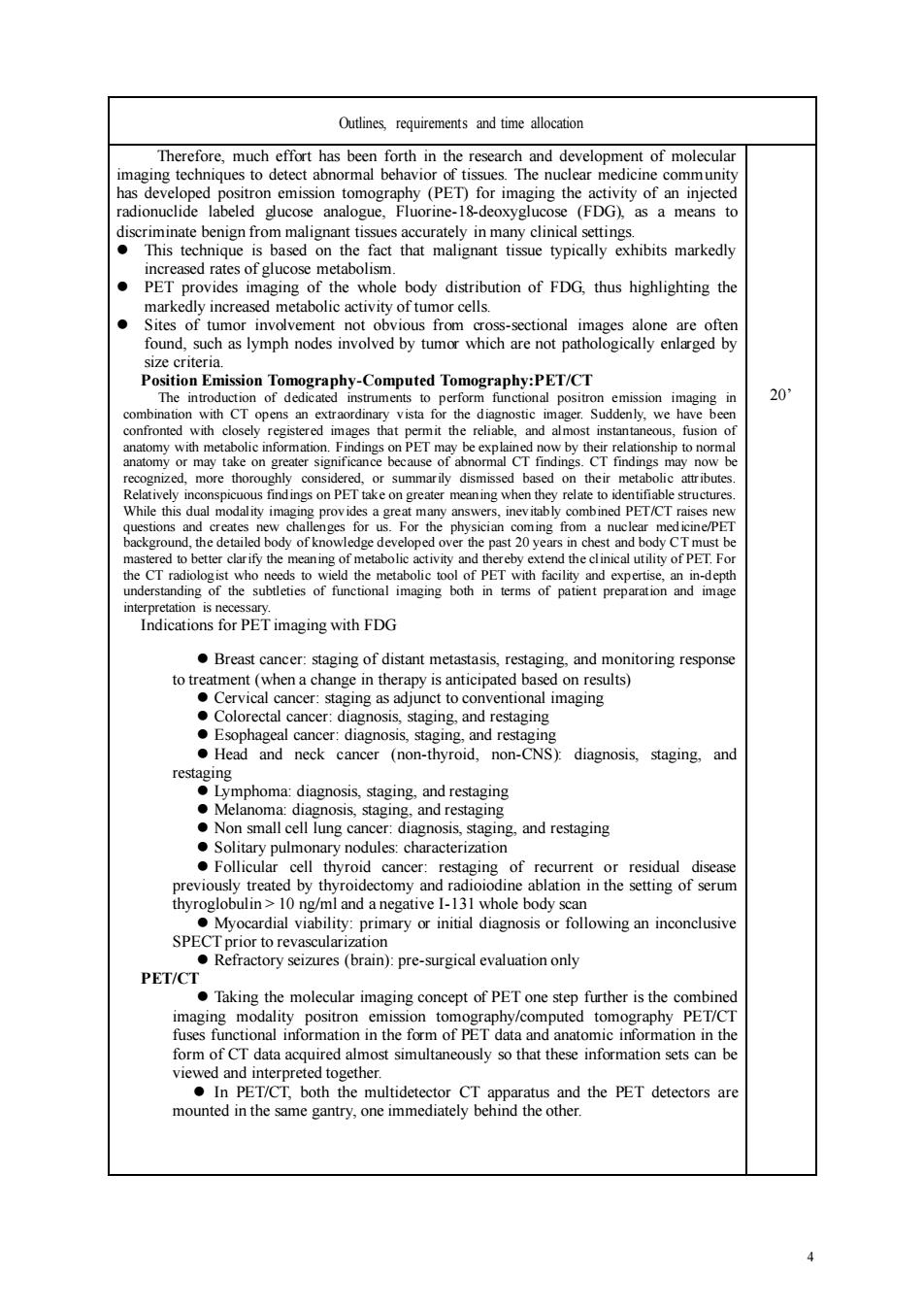正在加载图片...

Outlines requirements and time allocation Therefore.much effort has been forth in the research and development of molecular abnormal The nu ear medicir ne community radionuclid labeloue-(FDmean PEprovid minfthehbodyisribution of FG thus highlighting the poies involyed by tumor which ar o o alone are ofte 20 on grea or on their ●Breas过cancer staging of distant metastasis .and monitoring response to treatment (when a change in therapy is anticipated based on) Head and neck cancer (non-thyroid,non-CNS diagnosis,staging.and mphoma diagnosis staging and restagins .and restaging ●on sma larCCrdenoiaene、andrctaeng Follicular cell thyroid cancer:restaging of recurrent or residual diseas ablation in the setting of serum Myocardial viability:primary or initial diagnosis or following an inconclusive PET/CT Taking the molecular imaging conept of PETone step further is the combined form ofCT data acquired almost simultaneously so that these information sets can be4 Outlines, requirements and time allocation Therefore, much effort has been forth in the research and development of molecular imaging techniques to detect abnormal behavior of tissues. The nuclear medicine community has developed positron emission tomography (PET) for imaging the activity of an injected radionuclide labeled glucose analogue, Fluorine-18-deoxyglucose (FDG), as a means to discriminate benign from malignant tissues accurately in many clinical settings. ⚫ This technique is based on the fact that malignant tissue typically exhibits markedly increased rates of glucose metabolism. ⚫ PET provides imaging of the whole body distribution of FDG, thus highlighting the markedly increased metabolic activity of tumor cells. ⚫ Sites of tumor involvement not obvious from cross-sectional images alone are often found, such as lymph nodes involved by tumor which are not pathologically enlarged by size criteria. Position Emission Tomography-Computed Tomography:PET/CT The introduction of dedicated instruments to perform functional positron emission imaging in combination with CT opens an extraordinary vista for the diagnostic imager. Suddenly, we have been confronted with closely registered images that permit the reliable, and almost instantaneous, fusion of anatomy with metabolic information. Findings on PET may be explained now by their relationship to normal anatomy or may take on greater significance because of abnormal CT findings. CT findings may now be recognized, more thoroughly considered, or summarily dismissed based on their metabolic attributes. Relatively inconspicuous findings on PET take on greater meaning when they relate to identifiable structures. While this dual modality imaging provides a great many answers, inevitably combined PET/CT raises new questions and creates new challenges for us. For the physician coming from a nuclear medicine/PET background, the detailed body of knowledge developed over the past 20 years in chest and body CT must be mastered to better clarify the meaning of metabolic activity and thereby extend the clinical utility of PET. For the CT radiologist who needs to wield the metabolic tool of PET with facility and expertise, an in-depth understanding of the subtleties of functional imaging both in terms of patient preparation and image interpretation is necessary. Indications for PET imaging with FDG ⚫ Breast cancer: staging of distant metastasis, restaging, and monitoring response to treatment (when a change in therapy is anticipated based on results) ⚫ Cervical cancer: staging as adjunct to conventional imaging ⚫ Colorectal cancer: diagnosis, staging, and restaging ⚫ Esophageal cancer: diagnosis, staging, and restaging ⚫ Head and neck cancer (non-thyroid, non-CNS): diagnosis, staging, and restaging ⚫ Lymphoma: diagnosis, staging, and restaging ⚫ Melanoma: diagnosis, staging, and restaging ⚫ Non small cell lung cancer: diagnosis, staging, and restaging ⚫ Solitary pulmonary nodules: characterization ⚫ Follicular cell thyroid cancer: restaging of recurrent or residual disease previously treated by thyroidectomy and radioiodine ablation in the setting of serum thyroglobulin > 10 ng/ml and a negative I-131 whole body scan ⚫ Myocardial viability: primary or initial diagnosis or following an inconclusive SPECT prior to revascularization ⚫ Refractory seizures (brain): pre-surgical evaluation only PET/CT ⚫ Taking the molecular imaging concept of PET one step further is the combined imaging modality positron emission tomography/computed tomography PET/CT fuses functional information in the form of PET data and anatomic information in the form of CT data acquired almost simultaneously so that these information sets can be viewed and interpreted together. ⚫ In PET/CT, both the multidetector CT apparatus and the PET detectors are mounted in the same gantry, one immediately behind the other. 20’